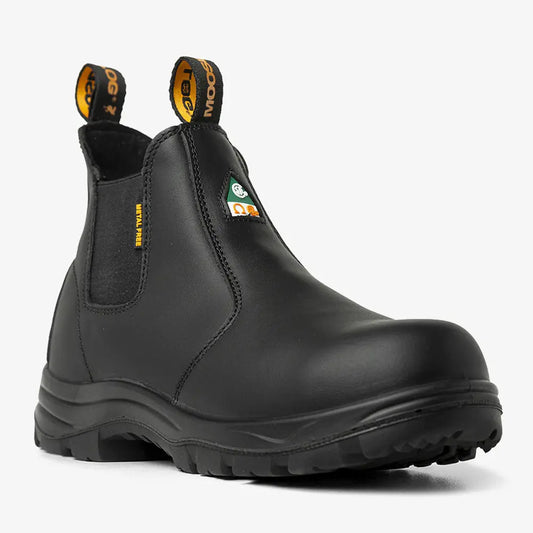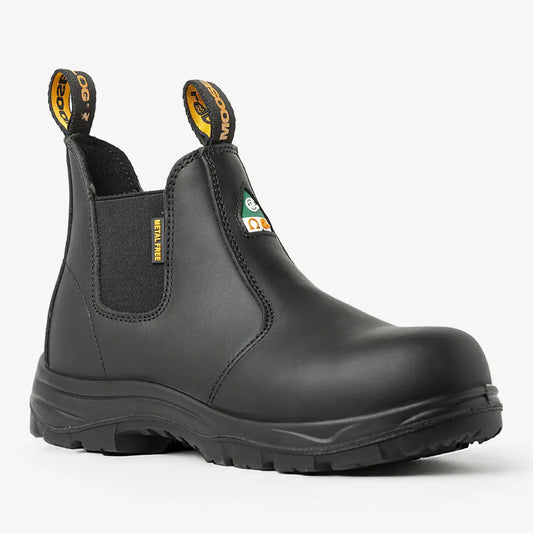
What Makes a Great Pair of Work Boots for the Canadian Winter? | MooseLog QnA
Winter work boots need to perform through freezing temperatures, snow, and ice. A great pair locks in warmth, blocks out moisture, and grips on slick ground. In Canada, that means proper insulation, waterproof leather, and a sole that stays flexible in the cold. The goal is steady warmth and traction from the start of your shift to the end.
Are Insulated Work Boots Necessary in Canada?
It fully depends on your specific job and location.
The need for insulated work boots is a matter of thermal comfort and risk prevention, but it's not a universal legal requirement under Canadian Standards Association (CSA) regulations.
When it's a necessity: Insulated boots are essential for workers exposed to outdoor cold for extended periods such as construction, oil and gas, roadwork, and utility maintenance. In these environments, insulation acts as a safety measure against frostbite.
When it's optional: Insulated boots are optional for indoor or mixed-environment trades such as electricians, warehouse operators, or plumbers. For these roles, CSA-approved boots combined with wool or synthetic thermal socks often provide the right balance of warmth and breathability, preventing overheating.
In summary: The necessity of insulation depends on your workplace hazard assessment. Specifically, how long you’re exposed to the cold, not the simple fact of working in Canada.
Why Is Composite Toe Better for Winter Conditions?
Composite toe caps are made from non-metallic materials such as Kevlar, fibreglass, or carbon fibre. They do not transfer cold the way steel does, keeping your toes warmer in freezing air. Composite also reduces overall boot weight, which helps prevent fatigue during long shifts. Many Canadian trades rely on CSA-approved composite toe boots precisely for reliable protection with thermal comfort.
What Is the Warmest Material for Winter Work Boots?

Full-grain leather remains the benchmark. It resists cracking, seals out snow, and molds to your foot over time. Combined with sealed seams, waterproof membranes, and fleece or thermal linings, it creates a barrier against slush and wind. Rubber or TPU outsoles stay flexible under cold pressure, improving stability and traction on icy ground.
How Do I Choose the Right Work Boots for Snow and Ice?
Slip resistance matters most. Deep lug tread patterns and certified SRA or SRO-tested outsoles provide security on wet and frozen surfaces. Some boots feature micro-glass or silica-infused rubber for extra bite on ice. If your work involves frequent outdoor travel or uneven ground, choose a tread with a self-cleaning design so snow doesn’t pack between lugs.
Are CSA Approved Work Boots Warm Enough for Winter?
CSA certification guarantees safety against impact, compression, and electrical hazards. Warmth depends on added features such as insulation and moisture control. The best CSA winter boots integrate both: safety standards plus thermal comfort. Look for models that are built specifically for subzero job sites, with waterproof uppers, composite protection, and slip-tested soles.
What Features Should I Look for in Winter Safety Boots?
Key elements include:
- Composite toe for cold resistance and safety compliance
- Puncture-resistant plate
- Waterproof leather or membrane
- Insulation matched to activity level
- Slip-resistant rubber outsole
- Breathable lining to release trapped heat
- Room to accommodate thicker socks
Always test fit with your preferred socks before buying. Tight boots restrict circulation, which makes feet colder faster.
How Can I Keep My Work Boots Warm and Dry All Season?
Proper care makes a difference. Dry your boots every night by removing insoles and letting air circulate inside. Avoid direct heat, which can crack leather. Use a boot dryer or a warm-air vent instead. Apply conditioner and waterproofing wax weekly, and rotate between two pairs if possible. Keeping your socks dry throughout the day, as soon as it gets wet swap a pair, helps prevent chill and odour buildup.
Which Work Boots Last Longest in Canadian Winters?
Durability depends on construction. Direct-injection soles handle temperature swings without separation. Goodyear welted designs allow resoling for extended use. Regular cleaning removes road salt, which eats into stitching. Condition the leather often to maintain flexibility and prevent splitting at stress points.
Conclusion
Canadian winters push gear to the limit. The right work boots combine insulation, traction, waterproofing, and a composite toe that holds warmth where steel cannot. Pair them with quality wool socks, care for them daily, and they’ll perform through every storm and shift.






